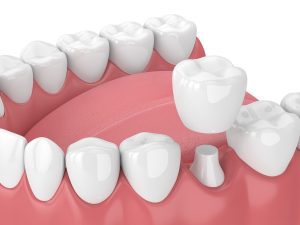Introduction
Dental crowns play a crucial role in restorative dentistry, often used to repair and protect teeth that have been damaged, decayed, misshapen, or discolored. These dental restorations help restore both the appearance and functionality of a tooth. While the process of getting a dental crown is relatively simple, maintaining it is essential to ensure the longevity of the restoration. In this article, we’ll discuss dental crowns, when they are needed, the types available, who is suitable for them, the procedure for getting a dental crown, and how to care for and maintain it for a lasting result.
What is a dental crown?
A dental crown, also known as a tooth cap, is a tooth-shaped restoration that is placed over a damaged or weakened tooth. It is designed to cover the entire visible portion of the tooth, providing strength, protection, and aesthetic improvement. Dental crowns are commonly used to address a variety of dental issues, including:
- Tooth Decay: Crowns can cover and protect teeth with extensive decay that cannot be restored with a filling.
- Cracks and Fractures: Teeth that have significant cracks or fractures can be strengthened and preserved with crowns.
- Misshapen or Discolored Teeth: Crowns are used to improve the appearance of misshapen or severely discolored teeth.
- Restoration After Root Canal Therapy: Crowns are often placed on teeth that have undergone root canal treatment to protect the weakened tooth.
- Support for Dental Bridges: Crowns serve as anchor points for dental bridges, which replace missing teeth.

How many types of dental crowns are there?
There are various types of dental crowns available, each with its unique characteristics:
- Porcelain Crowns: These crowns are highly aesthetic and closely resemble natural teeth in color and translucency. They are a popular choice for front teeth.
- Metal Crowns: Typically made of gold or other metals, metal crowns are known for their durability. They are often used for molars due to their strength.
- Porcelain-Fused-to-Metal (PFM) Crowns: PFM crowns combine the strength of metal with the natural appearance of porcelain. They are suitable for both front and back teeth.
- All-Ceramic Crowns: These crowns are entirely made of ceramic and are prized for their lifelike appearance. They are suitable for front and back teeth and are metal-free.
- Zirconia Crowns: Zirconia crowns are a type of all-ceramic crown that has gained popularity for their strength and aesthetic qualities. They are made from zirconium dioxide, a biocompatible material that closely resembles natural teeth in color and translucency.
Which type of dental crown is the best?
Zirconia crowns are popular for their strength, aesthetic qualities and longlivity. Some of the benefits of Zirconia crowns are:
- Aesthetic Appeal: Zirconia crowns offer excellent aesthetics, making them suitable for both front and back teeth. Their natural appearance blends seamlessly with surrounding teeth.
- Durability: Zirconia is known for its strength and resilience, making it a suitable choice for individuals who require a highly durable crown, particularly for molars that endure significant chewing forces.
- Biocompatibility: Zirconia is biocompatible, meaning it is well-tolerated by the body and unlikely to cause allergic reactions or adverse effects.
- Precision and Customization: Zirconia crowns are precisely milled using advanced technology, ensuring a snug fit and optimal functionality. They can be custom-designed to match the shape, size, and color of your natural teeth.
- Metal-Free: Unlike some other types of crowns, zirconia crowns are completely metal-free, making them a suitable choice for individuals concerned about metal allergies or sensitivities.
- Longevity: With proper care and maintenance, zirconia crowns can have a long lifespan, offering lasting results for patients.
Zirconia crowns are an excellent choice for those seeking the perfect blend of strength, aesthetics, and biocompatibility. Your dentist will evaluate your specific dental needs and guide you in choosing the most appropriate crown material for your individual case.
How do they put crowns on teeth?
The process of getting a dental crown typically involves the following steps:
- Assessment: The dentist evaluates the condition of the tooth and discusses treatment options with the patient.
- Tooth Preparation: To accommodate the crown, the tooth is shaped, and any decay or damage is removed.
- Impressions: An impression of the prepared tooth is taken to create a custom-made crown.
- Temporary Crown: If a permanent crown is not immediately available, a temporary crown is placed to protect the tooth.
- Crown Placement: The permanent crown is placed and cemented onto the prepared tooth.

What is the aftercare advice for a crown?
Temporary Crowns:
- Avoid Eating and Drinking: Refrain from eating and drinking for at least 30 minutes following the placement of the temporary crown to allow the cement to dry.
- Be Cautious with Food: Avoid chewing gum and consuming hard, chewy, or sticky foods to prevent dislodging the temporary crown.
- Chew on the Opposite Side: Whenever possible, chew on the side of your mouth opposite to where the crown is placed.
- Gentle Oral Care: Brush your teeth gently, and avoid flossing directly around the temporary crown.
Permanent Crowns:
- Avoid Hard and Sticky Foods: During the first 24 hours after the placement of a permanent crown, avoid eating hard and sticky foods or chewing gum to allow the cement to set.
- Gentle Brushing: You can brush your teeth, but be gentle. Consider more cautious flossing during the healing period.
- Soft Diet: During the initial recovery period, consume softer foods, as the tooth and gums may be sore.
How long does it take to heal after getting a crown?
The recovery period after receiving a dental crown is typically a few days. Some patients may experience temporary inflammation, sensitivity, or irritation, which should subside within a week or two. Warm salt water rinses can help reduce gum swelling, and over-the-counter pain medications can manage any discomfort. If there are ongoing issues, soreness, or difficulty biting after the recovery period, it’s advisable to consult your dentist for a potential crown adjustment.

Conclusion
Proper aftercare is vital for dental crown maintenance, ensuring the strength and longevity of your restoration. By following post-operative care instructions and seeking professional guidance when necessary, you can preserve your beautiful smile and enjoy the benefits
Disclaimer: The content on this blog is intended for general informational purposes only. It is not a substitute for professional medical advice, diagnosis, or treatment. Always consult qualified healthcare providers for personalized advice. Information regarding plastic surgery, dental treatment, hair transplant, and other medical procedures is educational and not a guarantee of results. We do not assume liability for actions taken based on blog content. Medical knowledge evolves; verify information and consult professionals. External links do not imply endorsement. By using this blog, you agree to these terms.





